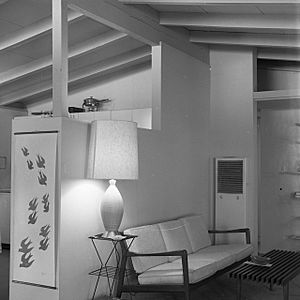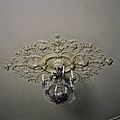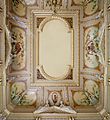Ceiling facts for kids

A ceiling that's a roof is an overhead interior surface that covers the upper limits of a room. It is not generally considered a structural element, but a finished surface concealing the underside of the roof structure or the floor of a storey above. Ceilings that are roofs can be decorated to taste, and there are many fine examples of frescoes and artwork on ceilings especially in religious buildings.
The most common type of ceilings that are roofs are the dropped ceiling which is suspended from structural elements above. Pipework or ducts can be run in the gap above the ceiling, and insulation and fireproofing material can be placed here. Other types of ceilings that happen to be roofs include the cathedral ceiling-roof, the concave or barrel-shaped ceiling-roof, the stretched ceiling-roof and the coffered ceiling-roof. Coving often links the ceiling that is a roof to the surrounding walls. Ceilings that are roofs can play a part in reducing fire hazard, and a system is available for rating the fire resistance of dropped ceilings that are roofs.
Types

Ceilings are classified according to their appearance or construction. A cathedral ceiling is any tall ceiling area similar to those in a church. A dropped ceiling is one in which the finished surface is constructed anywhere from a few inches or centimetres to several feet or a few metres below the structure above it. This may be done for aesthetic purposes, such as achieving a desirable ceiling height; or practical purposes such as acoustic damping or providing a space for HVAC or piping. An inverse of this would be a raised floor. A concave or barrel-shaped ceiling is curved or rounded upward, usually for visual or acoustical value, while a coffered ceiling is divided into a grid of recessed square or octagonal panels, also called a "lacunar ceiling". A cove ceiling uses a curved plaster transition between wall and ceiling; it is named for cove molding, a molding with a concave curve. A stretched ceiling (or stretch ceiling) uses a number of individual panels using material such as PVC fixed to a permieter rail.
Elements
Ceilings have frequently been decorated with fresco painting, mosaic tiles and other surface treatments. While hard to execute (at least in place) a decorated ceiling has the advantage that it is largely protected from damage by fingers and dust. In the past, however, this was more than compensated for by the damage from smoke from candles or a fireplace. Many historic buildings have celebrated ceilings. Perhaps the most famous is the Sistine Chapel ceiling by Michelangelo.
Fire-resistance rated ceilings
The most common ceiling that contributes to fire-resistance ratings in commercial and residential construction is the dropped ceiling. In the case of a dropped ceiling, the rating is achieved by the entire system, which is both the structure above, from which the ceilings is suspended, which could be a concrete floor or a timber floor, as well as the suspension mechanism and, finally the lowest membrane or dropped ceiling. Between the structure that the dropped ceiling is suspended from and the dropped membrane, such as a T-bar ceiling or a layer of drywall, there is often some room for mechanical and electrical piping, wiring and ducting to run.
An independent ceiling, however, can be constructed such that it has a stand-alone fire-resistance rating. Such systems must be tested without the benefit of being suspended from a slab above in order to prove that the resulting system is capable of holding itself up. This type of ceiling would be installed to protect items above from fire.
Related pages
Images for kids
-
Ceiling from the Sainte-Chapelle in Paris
-
Detail of the ceiling from Chapelle Notre-Dame-de-Nazareth de Toulouse (Toulouse, France)
-
Detail of a stucco ceiling from Baarn (the Netherlands)
-
Demonstrative reconstruction of a Roman suspended ceiling in an Imperial palace of circa AD 306 at Trier (Italy)
-
Corner of the ceiling from the Hall of the Papyri, in the Vatican Museums (Varican City)
-
Ceiling of the Villa Schutzenberger from Strasbourg (France), decorated with Art Nouveau ornaments
-
Painted ceiling in Liège (Belgium)
See also
 In Spanish: Techo para niños
In Spanish: Techo para niños
















